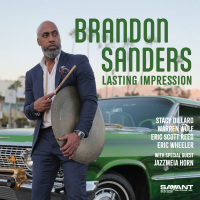Home » History of Jazz Timeline: 1941
History of Jazz Timeline: 1941
Bop begins in New York City. At first, Bop is only a few new ideas.
The Minton guys (see 1940) hear of an obscure alto sax player named Charlie Parker who is now playing at Clark Monroe's Uptown House. They go to hear Charlie. He's doing similar things to the things that they are doing but he's way ahead. Kenny Clarke and Thelonious Monk arrange for Parker to sit in at Minton's. The stage is set.
Charlie Parker is still with Jay McShann. Charlie makes his first recordings for Decca. His style is by now discernable. His playing is confident and strong. Charlie meets Dizzy Gillespie when Diz sits in with McShann at the Savoy Ballroom. The Boppers hit 52nd Street. Parker begins to sit in at Minton's (the breeding ground of Bop).
Dizzy Gillespie is well schooled in music. This is particularly important in building a theory to support Bop. In May, Dizzy is playing primarily in the Roy Eldridge mold, but he is slipping into the Bop-like stuff that he'd been fooling around with for two years.
Bud Powell meets the creators of Bop at Minton's (an event later immortalized in the Monk song In Walked Bud). He will become Bop's premiere pianist.
Others at Minton's include Monk on piano, Kenny Clarke on drums and Dizzy on trumpet. Monk will become a high priest of Bop. Parker and Dizzy are given credit for founding it. Clarke developed the rhythm on which it sits.
The guys at Minton's after hours sessions were playing something close to Bop at this time, but no one could imitate it because it hadn't been recorded yet. The recording ban (starting in 1942) will make the development of the new Bop something of a romantic mystery even to this day.
A quote from Tony Scott: "When Bird and Diz hit the street [52nd Street] regularly, everybody was astounded and nobody could get near their way of playing music. Finally, Bird and Diz made records, and then the guys could imitate it and go from there."
Art Blakey stated years later that Monk was the guy who started it all, not Parker or Gillespie. On a few recordings made by Jerry Newman at Minton's, Monk seems to be Tatum influenced at this point. His style will become much sparer.
Kenny Clarke's new Bebop style of drumming (see 1937) is finally documented on a May recording at Minton's.
Bop players are substituting different but related chords for normal, mainstream "Swing" chords. Rhythm changes in Bop are bigger than the harmonic changes however. They are using faster tempos for fast songs and slower tempos for slow songs. The beats are divided more evenly for fast songs and fast tempos than Swing.
Bop players are deliberately playing "off-beat".
Eddie "Cleanhead" Vinson joins the Cootie Williams orchestra.
Roy Eldridge becomes the first black performer to be accepted as a permanent member of a white big band when he joins drummer Gene Krupa's big band.
John Coltrane's mother moves to Philadelphia.
Coltrane receives a clarinet as a gift and he joins community and school bands in High Point, North Carolina. Later in high school, after hearing Johnny Hodges, Coltrane decides to play the alto saxophone. Lester Young is among his favorite musicians.
The Ellington Band continues on what critics say is its best period. Duke records such favorites as I Got it Bad and That Ain't Good, Take the A-Train, The Brown Skin Gal, Chelsea Bridge, etc. See Bluebird CD Duke Ellington - The Blanton-Webster Years.
Duke records as a soloist for the first time.
Vibes man Lionel Hampton leaves Benny Goodman to form his own big band.
Cab Calloway is hit by a spitball during a concert in Hartford, Connecticut. Although trumpeter Jonah Jones probably threw it, Calloway blamed Dizzy Gillespie. A fight ensued and Calloway was nicked by a knife. Dizzy was fired.
Check out Joe Thomas's trumpet masterpiece Stompin' at the Savoy with Art Tatum, Joe Turner and Edmond Hall.
Future piano innovator Bill Evans is asked to sit in for a missing pianist in his brother's Jazz group.
Stan Kenton forms his first band.
Gil Evans joins the Claude Thornhill band. The band moves in the direction of Bop.
Bassist and future composer Charlie Mingus gets a job with Louis Armstrong's big band.
Billie Holiday begins an affair with drug addict Jimmy Monroe and becomes addicted to drugs herself.
Charlie Christian collapses from tuberculosis, which he had for a few years. He is sent to Seaview Sanitarium on Staten Island.
Swing is both peaking and on its way out. It will become defunct because the younger musicians will be drawn to Bop. But, currently, bands such as Benny Goodman Band, Glenn Miller Band, Tommy Dorsey Band, etc. are as highly regarded as the Beatles will become in the 60's.
Mel Powell, a Hines-like piano player, joins the thriving Goodman Band.
Tenor saxophone player Chu Berry is killed in a automobile accident.
Jelly Roll Morton dies on July 10 in Los Angeles.
Dixieland trumpeter Wild Bill Davison moves to New York where he becomes a regular at Nick's and Condon's.
Otis Redding is born in Georgia.
Saxophonist Lester Young turns Jack Kerouac, the founding father of the "beat generation", on to his first marijuana cigarette.
Keyword Search
Disclaimer: Though we have checked our facts, this timeline may contain erroneous information. If you discover errors or omissions, please bring them to our attention.









